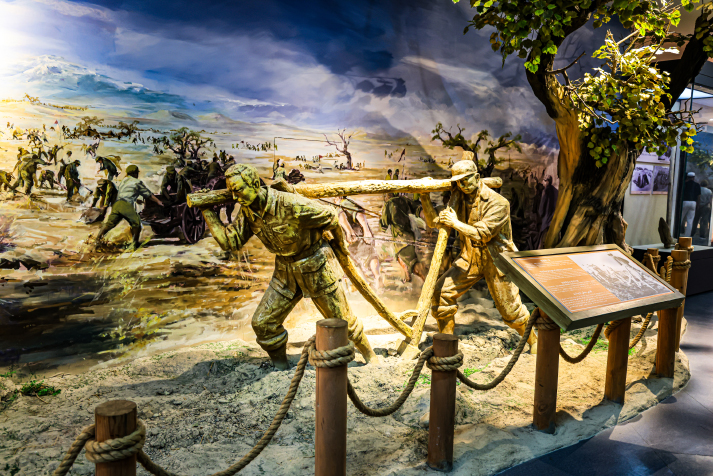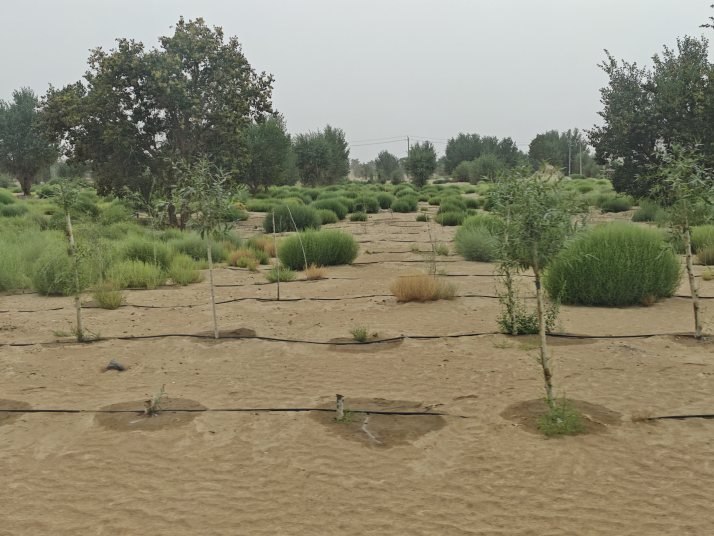| Xinjiang Today |
| Alaer: the story of a desert pearl | |
|
|
 A bird's-eye view of Alaer City in September 2024 (XINHUA)
Alaer (Aral) is a city built up by the Xinjiang Production and Construction Corps (XPCC). The city's history is thus intertwined with the development of the XPCC, which is a special system set up in 1954 in the early years after the founding of the People's Republic of China. It is primarily composed of demobilized service people who have left the armed forces to take on tasks such as frontier settlement and defense, construction, as well as maintaining stability.
Alaer is where the XPCC First Division is stationed and is therefore called the city of the First Division. In the 1950s, the troops of the First Division came to the northern edge of the Taklimakan Desert, where they dug channels to bring water across the sandy terrain, planted trees and reclaimed the land—gradually building farms, regiments and settlements. This is how the city of Alaer started to take shape.  A sculpture at an Alaer museum shows how XPCC members reclaimed wasteland (VCG)
Some visitors might misunderstand "the city of the XPCC" as a city managed by the army or a city under military rule. This assumption, however, is incorrect. A distinguishing feature of the XPCC isn't that it is composed of "army men"; rather, it has established an almost autonomous social operating system in remote and outlying regions. Simply put, it serves both as a corporate entity and a living community. Beyond growing crops and operating factories, the XPCC runs its own schools, builds hospitals, constructs housing and manages the community. The residents are factory or farm workers and also local city dwellers, and all their education, medical care, housing and social security needs are coordinated and provided by the XPCC's own system. This system arose because many of the places where the XPCC is stationed are vast, sparsely populated and far away from big cities, making it impractical to rely on local governments for public services. To enable people to settle in these regions for the long term, the XPCC had to take on production, livelihood and social governance itself. So an XPCC farm is typically both an economic entity and a miniature town, complete with schools, hospitals, police stations, shops and a cultural center—essentially a self‑contained community. The merit of this model is that it enables frontier areas to operate autonomously—without relying on external resources—while maintaining social order and economic vitality. Thus, a garrison town becomes a distinctive entity: Not a town under military jurisdiction, it is a highly organized social unit with a comprehensive set of functions. The birth and growth of Alaer is a section of history written by XPCC pioneers. From a desolate wasteland to a bustling town, Alaer showcases their courage to take roots in the harshest environments and turn the impossible into possible through organized efforts and hard work.  The Desert Gate scenic area on August 12 (XINHUA)
From wasteland to oasis The Taklimakan Desert, an ancient wasteland dubbed the "sea of death," used to be cruel reality that local people had to face up to. Today, the desert has become Alaer's shiniest name card. Behind this change is a heroic saga of struggle that spans more than half a century and a quest to mine treasures from the wilderness. In the late 1950s, the pioneers arrived on the Gobi wasteland along the southern bank of the Tarim River to build Alaer. In the days when machines were scarce, they relied on basic hand tools, like mattocks and shovels, to dig ditches and lay roads. They lived in earth-walled dwellings, toiled day after day and managed to survive in an area where the incredible gusts of wind would even move big stones. In the 1970s, the construction brigades were converted into agricultural regiments that began to grow grain in the sands. Every day, XPCC staff started to work before dawn and finished when the sky turned dark. Repeated experiments on saline-alkaline soils eventually enabled cotton and grain crops to survive and expand steadily across the land, laying the groundwork for subsequent development.  Sand control plants dot the city of Alaer (SHANG ZHOUHAO)
The No.11 XPCC Regiment is stationed along the northern edge of the Taklimakan Desert. The dunes there feature steep elevation changes and complex terrains, making the area a natural off-road racing arena. Noticing the potential value of the sands, Alaer City developed an off-road racing base there. Step by step, a scenic area called the Desert Gate materialized, which provides desert off-road racing routes, a starlit camping base, a waterfront area and a zone for experiencing the XPCC culture. According to Wang Changsong, general manager of the scenic area, the scenic spot receives around 600,000 visitors on average each year, and several specialized tourism-centered cooperative enterprises have been set up in the neighboring areas, generating more than 1,000 jobs and helping increase local resident income. Looking back to the shift from wasteland to oasis, the Desert Gate seems to be more of a symbol. It represents the transformation from an early-stage struggle for survival on the desert's edge by engaging in production and construction, to the improvement of the desert ecosystem, and to the eventual conversion of desert resources into growth opportunities through new industries like tourism. After half a century's relentless efforts, the path forward is becoming increasingly wider and brighter.  XPCC First Division workers harvest chili peppers on September 9, 2024 (VCG)
Partnership of development
While Alaer has been built by generations of XPCC workers, its development is also inseparable from the continued support from other parts of the country under the paired assistance program. Starting from 1997, Central Government departments, centrally administered state-owned enterprises and several provinces and municipalities began to dispatch cadres and other talented people to Xinjiang, providing support across a wide spectrum—from human resources to science and technology, education, healthcare, culture, etc. In 2010, the Central Government further made it clear that 19 provinces and municipalities in east and central China should offer assistance to Xinjiang, thus inaugurating a new phase of all-round and multi‑level support. The 10th work conference on paired assistance for Xinjiang convened in Hetian in July 2025, mapping out a systematic plan and deployment for assistance in the new era, furthering this cause. Zhejiang Province's assistance to Xinjiang vividly epitomizes this national strategy. Under the paired assistance program, a batch of Zhejiang enterprises set up businesses in Alaer. The Rural Revitalization refrigerated freight train, launched in late 2024, now crosses a distance of 4,800 km between Alaer and Taizhou of Zhejiang, linking local producers directly to distant markets. Zhejiang's Daha Chuxing Intelligence Technology Co. Ltd. has set up a subsidiary in Alaer, adding a capacity of 100,000 electric vehicles annually and thousands of jobs. Crab seedlings from Huzhou of Zhejiang as well as supportive aquaculture technologies make saline-alkaline water aquaculture a new source of income for Alaer residents. Assistance in education is another important part of the paired assistance strategy. Through dedicated programs, several vocational colleges in Zhejiang are now offering paired assistance to Tarim Vocational Technical College and teachers from Zhejiang have come to schools in Alaer to help with local education. Regular paired assistance as well as exchanges between teachers and students further deepen communication between the two places in terms of educational concepts and culture. Medical support for Xinjiang directly benefits local livelihoods. Doctors from Zhejiang have successfully performed several highly complex surgeries and helped establish the first national regional medical center in the XPCC. They also launched an integrated emergency response system covering residents both inside and outside the XPCC. In addition, targeted programs have pointedly enhanced local health security, strengthening the capability of the XPCC's hospitals, and providing rehabilitation aid for children with disabilities. Chinese ancient poetry contests are regularly held for young students from Zhejiang and Alaer. Scenic spots like the Desert Gate are being upgraded thanks to Zhejiang's assistance targeting the tourism sector in Alaer. An array of cultural exchanges between the two places has greatly promoted communication and mutual learning. The story of Alaer is a saga of people venturing into the sands and building a home city in a desolated place. This city, a pearl in the desert, is now writing a new legend. Comments to shangzhouhao@cicgamericas.com |
|
||||||||||||||||||||||||||||
|